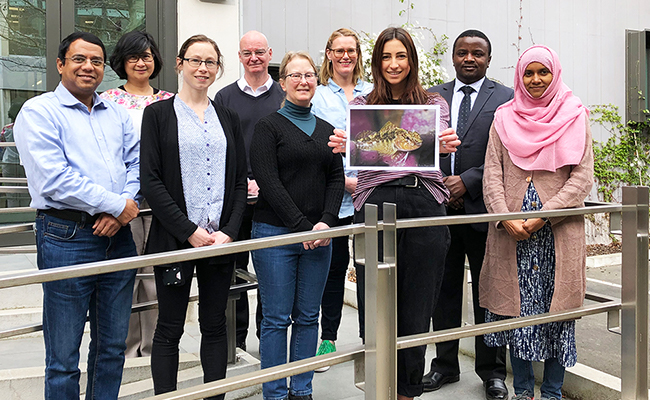
Members of the multidisciplinary research group Associate Professor Azam Ali (Food Science); Professor Indrawati Oey (Food Science); Dr Sara Miller (Chemistry); Professor Keith Gordon (Chemistry); Dr Candace Martin (Geology); Dr Bridie Allan (Marine Science); Ashleigh Hawke (Marine Science postgraduate); Dr Stephen Giteru (Food Science), Fatema Ahmmed (Chemistry postgraduate). Absent from photo are students Zoe Psarouthakis, Michael Stuart, and Peter Zhao.
Plastic pollution is recognised as a major problem for marine environments and a pressing need exists to find alternatives to help reduce the devasting impact plastic pollution is having.
The use of biodegradable, edible food coatings could be an answer, and an inter-disciplinary group is embarking on a novel collaborative study to explore this alternative to traditional petroleum-derived-plastics.
Lead by Dr Bridie Allan from the Department of Marine Science and supported by an Otago University research grant, the study is involving expertise across several Division of Science Departments including Food Science, Chemistry and Geology to address this multi-faceted challenge.
While biodegradable products have gained recent traction with the rise of sustainability, their impacts still remain largely unknown, and this will be the first study to test whether a biodegradable plastic has an effect on fish should they ingest it.
For the first phase of the project the Department of Food Science developed the edible film product, formulated from a mix of natural ingredients from plant-based protein and by-product of marine organisms.
“It's a huge project involving many departments, and exciting to think this could be paving the way for the development of a product that could provide a sustainable replacement to other plastics that we know are so detrimental to fragile marine communities.”
Food Science researchers explain the sustainable packaging product could have multiple uses such as disposable pouches, primary product contact and for the separation of layered foods.
The second stage of the project has just been completed and involved feeding low doses of edible film and polyethylene microplastics to 150 triplefin fish kept in separate tanks for a month at the Portobello Marine Lab.
This was followed by behavioural and physiological observations where Dr Allan and her team hope to determine whether biodegradable and petroleum derived plastics have the same impact on the fitness of fish.
Stage three of the research will involve an in-depth biochemical analysis of potential changes in neurotransmitters, liver quality, white muscle structure, and oxygenation impacts of the ingested edible film which will be undertaken by several departments.
Department of Food Science Professor Indrawati Oey says bringing experts together for this cross-departmental project is driven by the need to assess the impact of biodegradable film on sustainability and food systems in a more holistic and tangible way.
One area of particular interest for the research is the impact that heavy metals such as copper, lead, and mercury can have on behaviours, oxidative damage, and impairment to reproductive and developmental processes.
“It is important to understand the capacity of new materials like the edible film to transport these heavy metals which occur naturally in the environment, and importantly whether they then bio-accumulate in fish, which is what our analysis will be looking at,” Dr Allan says.
Dr Allan explains the rationale for this study is that if it affects these fish in any meaningful ways, then it could potentially impact humans in similar ways.
While the formulation of biodegradable edible films is breaking new territory, Food Science researchers point out that even though the ingredient materials come from the natural environment, they still require modification for which specific protocols do not yet exist.
“It's so fantastic to be able to get so much information from such a small fish,” Dr Allan says.
“It's a huge project involving many departments, and exciting to think this could be paving the way for the development of a product that could provide a sustainable replacement to other plastics that we know are so detrimental to fragile marine communities.”
Story by Guy Frederick (Communications Adviser, Division of Sciences)